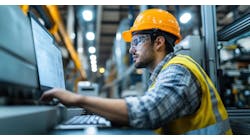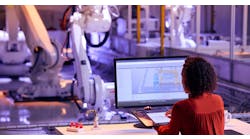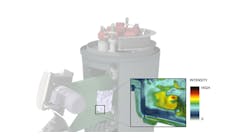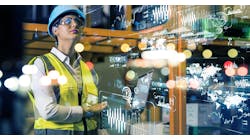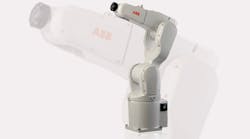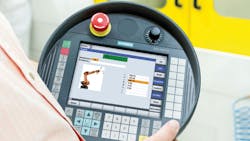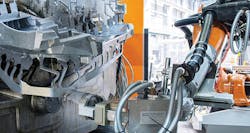Metalcasting operators and decision-makers have always understood the value a robot brings to their production processes: they deliver greater consistency and safety in demanding and risky tasks. But, for a decade or more the applications remained fairly consistent, and in that way routine: tending melting processes, filling molds, and handling large or heavy castings.
In recent years, however, robots’ role in foundries has expanded because of advances in automation technology. Note how it has become somewhat passé to speak of “robots” because the technological focus has shifted to the wider issues of motion control, system programming, and integrated production process, so that now it’s more accurate to discuss “robotics.”
Keying these changes has been the significant progress to simplify programming. As ABB Robotics vice president John Bubnikovich noted earlier this year, “With easier programming, small- and mid-sized companies are finding that increased productivity and efficiency are easier to attain without needing to hire an army of robot engineers to operate the robots.”
Last month, ABB Robotics introduced a new model kitted to withstand the heat, dust, and other environmental hazards for robots in metalcasting operations. It carries the requisite IP66/67 protection ratings, from base to wrist, meaning that the robot’s electrical compartments are sealed against liquid and solid contaminants. The device is also resistant to corrosion, and will withstand high-pressure steam washing.
The IRB 1200 Foundry Plus 2 is an update to the IRB 1200 introduced just two years ago, and according to the developer it is the smallest foundry-duty robot in its class. As for applications, the developer expects it to increase flexibility and reduce cycle times for precision diecasting processes, for example, such high-production operations producing as smart phone cases and other electrical components.
“Foundry robots have long contributed to the productivity and speed of heavy-duty metalcasting and automotive applications, and are now becoming increasingly important in consumer electronics applications to cast light weight metals,” commented Dr. Hui Zhang, head of product management, ABB Robotics. “This robot will allow our customers to increase productivity, deliver better workpiece quality, and reduce cycle times.”
The IRB 1200 Foundry Plus 2 comes in two variants, for handling a range of applications, and making it cost-effective due to the commonality of parts. The 700-mm reach variant can carry a payload of up to 7 kg; the longer reach 900-mm variant can carry up to 5 kg of payload.
While the robots are the means for metalcasting plants to achieve their production goals, it’s programming that defines their functions and flexibility. ABB Robotics continues to develop and improve its Robot Studio suite. RobotStudio 6.0, the software platform for programming, configuration and virtual commissioning of robotic functions, is fully accessible via touchpad, and a range of robotic control apps (e.g., calibration, editing, and jogging) are ready to commission functions wirelessly via tablets devices.
The ABB CP600 operator panels are offered in seven sizes, and allow users to integrate the robots with ABB PLCs and drives. All ABB robots are ready to be connected (wirelessly or hard wired) to an interconnected 24/7 ecosystem ABB called Connected Services (and described as “the Internet of Things, Services and People.”) It’s part of a long-term “digitalization strategy” that foresees all actionable data relayed via software from connected robots worldwide, to manage robot condition monitoring and diagnostics, backup management, remote access, fleet assessment, and asset optimization.
Working in Parallel
The parallel development to simplified programming is collaborative robotics — robots that sense objects and adapt their programmed objectives accordingly — and ABB’s entry into that field is the YuMi. Programming can be done from a wireless tablet, and the devices can work closely with human operators, in tasks like machine tending, dimensional gauging, small parts handling, or precision grinding. If an unexpected impact occurs, YuMi can pause “within milliseconds” and the motion then restarted easily.
For most metalcasting operations, programming remains the most important collaborative task, which as Siemens has noted is the first step to integrating sequential production steps. For part handling, loading, and unloading, Siemens developed a programming package that allows a robot to be operated from the same user interface as a production machine. Based on its Sinumerik Integrate CNC, RunMyRobot was developed to allow robots to load and unload machine tools for high-production milling, turning, grinding, and finishing.
The RunMyRobot package covers viewing the production workstation, including robots; programming, and operation; and diagnostics and display of robot messages, completely integrated in the CNC control interface. According to the developer, RunMyRobot speeds up workpiece and tool handling. Operation, teach-in, and diagnostics can be achieved from the Sinumerik 840D sl operator panel, raising the efficiency and flexibility of the specific production process.
For metalcasting operations, the possibility of automated and integrated operation is gaining probability because of robotics, but specially designed robots remain necessary because of the demands of the processes and the workspaces. Kuka Robotics is offering a range of 48 high-performance robot types especially for metalcasting, the KR Quantec F series. The units have protective coatings resistant to alkalis, acids, heat and corrosion, and they “permanently meet the requirements of protection ratings IP65/67.” They are offered as floor-, ceiling- and shelf-mounted devices, for payloads from 6 to 1,300 kg.
From high-precision light alloy diecastings to large, complex steel castings, Kuka contends the KR Quantec F series has devices for sand casting, diecasting, permanent mold casting, and handling heavy molds and finished components. It effortlessly handles payloads of up to 300 kg.
For example, the Kuka.Slip-Casting functions allow the robot to perform simple, precise tracking of a tilt-pour permanent-mold casting machine. It controls the positioning of the pouring ladle exactly and doses the flow of molten aluminum into the mold with precision, achieving quality cast results due to low-turbulence pouring.
On request, all Kuka robots based on the KR C4 controller can be controlled directly via a Siemens Sinumerik panel, meaning the operator needs no special knowledge of robotics to manage its performance.
Whether plant communications are based on field bus systems or via Ethernet with higher-level systems, the KR C4 can be integrated into existing infrastructures. It simplifies controlling external axes and synchronizing complex work processes (e.g., core setting, casting machine tending, finish grinding, etc.) All electronic elements are protected against dust and dirt by atmospheric overpressure in the housing. Kuka also emphasized that its “integrated energy management” means the KR C4 is able to achieve 95% savings in energy consumption (in standby and “eco” modes.)
The KR C4 series integrates robot control, motion control, and logic control with control modules for safety and CNC. This makes automation concepts built on KR C4 “more intelligent, flexible, and scalable,” the developer noted.
The universal interface makes Kuka robots easy to operate, and coordinating it with the Sinumerik RunMyRobot package means the operators can visualize, operate, program, and set up all in one familiar interface — the production machine’s control panel.
The progress of robotics technology is defined by the ability of operators to program the devices and coordinate their process more efficiently, which is giving metalcasters new standards for evaluating their performance expectations.


